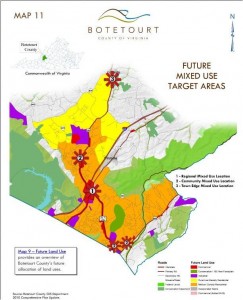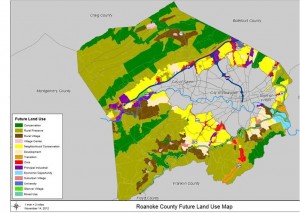Introduction and Background
This is the second article in a series of posts concerning Urban Development Areas (UDA) as it relates to transportation and the HB2 project prioritization process. The HB2 process, enacted in 2014 by the Virginia General Assembly, creates a new framework for the way in which the Commonwealth Transportation Board selects and prioritizes projects.
As was explained in the previous article, the Virginia Multimodal Transportation Plan or VTrans2040, has an initial screening process for potential HB2 projects. One of these three “screens”, as it were, is a UDA. The important takeaway here is that if the project does not serve a Corridor of Statewide Significance (CoSS) or Regional Network, a UDA or UDA-like district must be served by a proposed project. Many localities’ comprehensive plans have Village Center, Traditional Neighborhood Development, or Mixed-Use districts which are typically considered UDA-like.
State Grant Programs
Metropolitan Planning Organizations (MPO) and Planning District Commissions (PDC) throughout the Commonwealth have several opportunities to provide technical assistance to their member localities seeking UDA or UDA-Like designations.
The State’s Office of Intermodal Planning and Investment (OIPI) has issued opportunities to Virginia localities, in the form of direct on-call consultant support, and will assist local governments in one or more of the following:
- Plan/designate at least one urban/village development area in a locality’s comprehensive plan;
- Revise zoning and land use ordinances to incorporate the principles of traditional neighborhood design; and
- Assist with public participation processes, and other tasks.
The OIPI assistance is available through an application and award process with a deadline of August 31, 2015. This assistance is open to Virginia communities of all sizes. More information can be found on the OIPI website.
 Two of the localities served by the Roanoke Valley Transportation Planning Organization (RVTPO), Botetourt and Roanoke Counties, went through comprehensive plan processes to include either UDAs or high growth areas in their respective Future Land Use Maps. In Botetourt County’s 2011 Comprehensive Plan update, mixed-use target areas were identified on the Future Land Use Map along with references to the 2007 UDA legislation. Further, the County defined mixed use/village centers and provided design guidelines with the intent of coordinating land use and transportation.
Two of the localities served by the Roanoke Valley Transportation Planning Organization (RVTPO), Botetourt and Roanoke Counties, went through comprehensive plan processes to include either UDAs or high growth areas in their respective Future Land Use Maps. In Botetourt County’s 2011 Comprehensive Plan update, mixed-use target areas were identified on the Future Land Use Map along with references to the 2007 UDA legislation. Further, the County defined mixed use/village centers and provided design guidelines with the intent of coordinating land use and transportation.
 Roanoke County identified village and mixed use centers on their Future Land Use Map and defined them in the comprehensive plan. The governing body ultimately did not approve the UDAs, however the framework is virtually in place in the County’s Comp Plan.
Roanoke County identified village and mixed use centers on their Future Land Use Map and defined them in the comprehensive plan. The governing body ultimately did not approve the UDAs, however the framework is virtually in place in the County’s Comp Plan.
RVTPO Assisting its Localities in UDA Development
Here are some of the ongoing efforts that the RVTPO is doing with its localities to develop UDA/UDA-Like areas:
- The City of Salem, is currently underway with its OIPI-awarded technical assistance grant, and is on the way to UDA designation. RVTPO staff will be working with them in FY16 on phase II of the Salem Downtown Plan and provide applicable UDA technical assistance.
- Roanoke County will most likely pursue UDA-Like designated growth areas. Staff will coordinate with Roanoke County as they develop language for the Planning Commission and Board of Supervisors.
- The City of Roanoke’s Planning Commission met in June to recommend to Council the development of the city as a UDA. Staff will review any final proposal from the City for compliance with the Code of Virginia.
- Botetourt County will have comprehensive plan amendments going to public hearing in September and RVTPO and County staff will collaborate to develop the appropriate language and mapping.
There are several ways for MPO staffs to provide technical assistance and not feel as if they are taking a backseat.
- MPOs and PDCs have an obvious state mandated role in providing assistance. In 15.2-2223.1 (D) of the Code of Virginia, “Localities shall consult with adjacent localities, as well as the relevant planning district commission and metropolitan planning organization, in establishing the appropriate size and location of urban development areas to promote orderly and efficient development of their region.”
- MPOs and PDCs can initiate conversations with their localities to provide UDA technical assistance. The RVTPO is doing this through general technical assistance and specific projects in its Unified Planning Work Program.
- Be in the loop—MPO staff can perform specific tasks in connection with or separate from on-call consultants. The RVTPO is doing this with the City of Salem who was awarded a technical assistance grant.
- Work with localities to develop future growth areas or UDAs in a smart an organized fashion, not just as a means to a “transportation end”.
Consequences of Not Having UDAs or Future Growth Areas
If a locality’s project does not serve a CoSS or regional network, it will not be considered a qualified project under HB2. If not submitted by October 1, 2015, localities will have to wait until the next year’s cycle to apply, provided they have received approval from OIPI in the year since.
